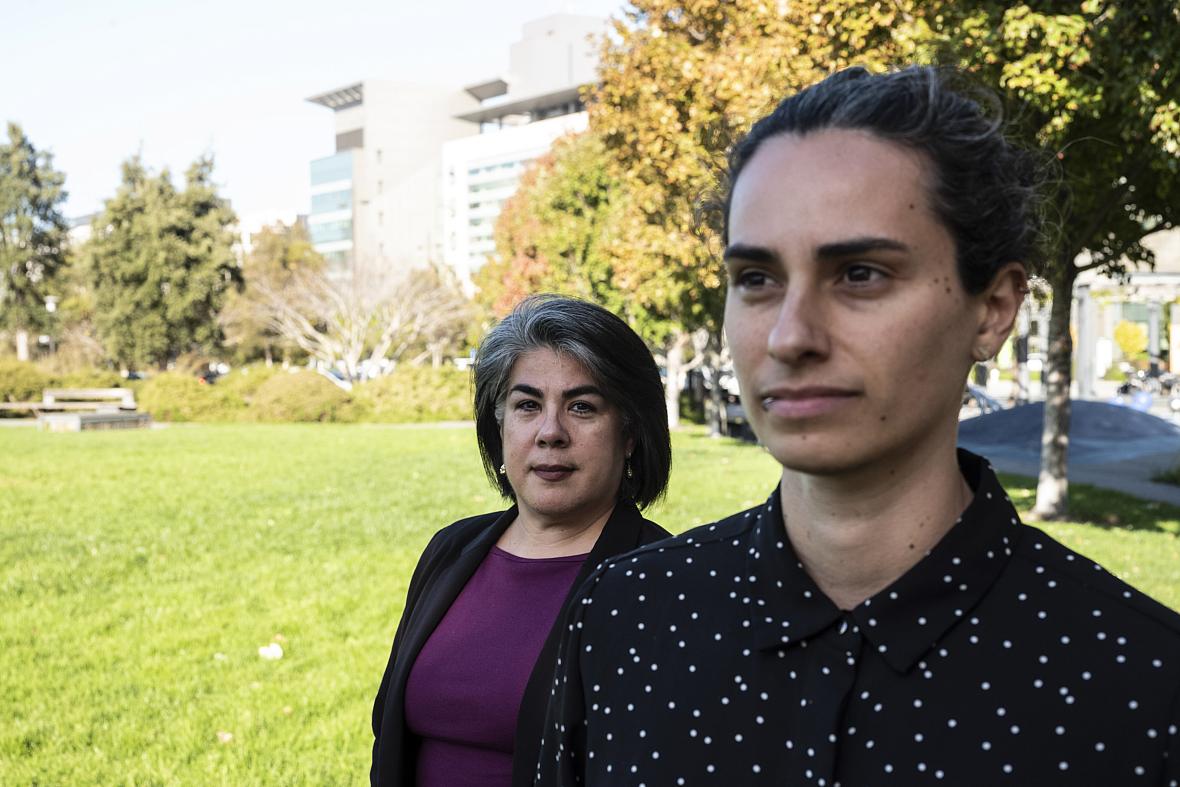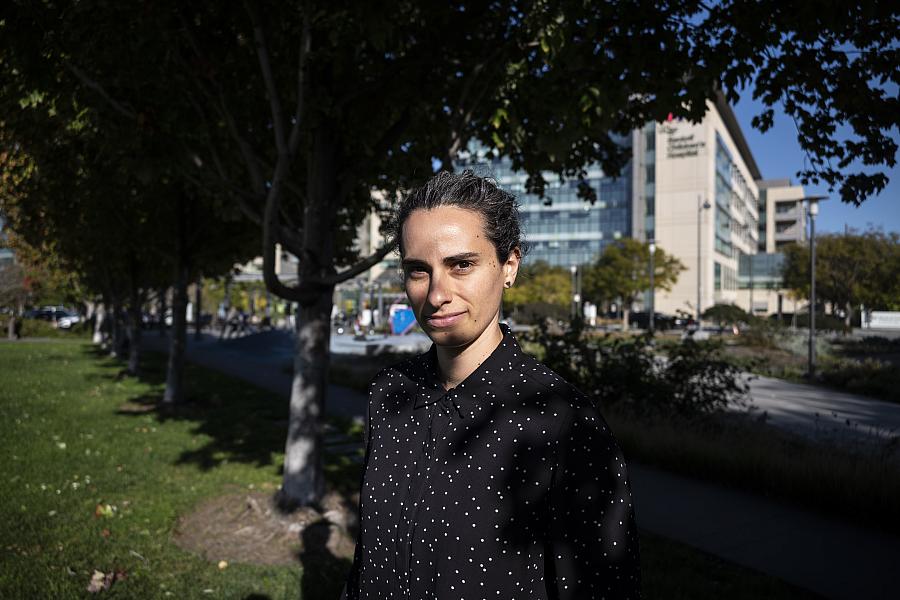Spanish Interpreters in San Francisco Juggle Heavy Work Loads As Patient Needs Grow
The story was co-published with El Tecolote as part of the 2025 Ethnic Media Collaborative, Healing California.

Medical interpreters Sarah Roberts, 34, and Isela Galvez Tovar, 54, of the University of California, San Francisco (UCSF), stand at Mariposa Park in San Francisco on Nov. 6, 2025. Amid UCSF’s hiring freeze and growing burnout among Spanish-speaking interpreters, workers are preparing to strike. Photo: Pablo Unzueta for El Tecolote / CatchLight Local
In her 15 years as a medical interpreter, Isela Galvez Tovar, 54, has helped countless of her Spanish-speaking patients understand their treatments and navigate the complexities of the U.S. healthcare system. Without this kind of language support, she worries that immigrant patients could walk away not understanding critical parts of their care.
Recently, she had to step in to ensure a Spanish-speaking family gave their sick child the correct amount of medication. Pharmacists had initially provided them a chart outlining a strict schedule and explained it through a video interpreter. But when Galvez Tovar arrived, she realized the family didn’t understand the diagram. Together, they developed a plan that made sense to them, allowing the rest of the visit to go smoothly.
Galvez Tovar is a medical interpreter at the University of California, San Francisco (UCSF). There, she bridges linguistic and cultural gaps for the hospital’s Spanish-speaking patients, explaining complex diagnoses, guiding medication instructions and offering emotional support as families process difficult news. Increasingly, though, Tovar and her colleagues say they can’t reach everyone who needs their help.
Interpreters have told El Tecolote that UCSF’s team is severely understaffed. The hospital, they said, currently employs 14 medical interpreters, only eight of whom speak Spanish, to cover the hospital’s three major campuses: Parnassus Heights, Mission Bay and Mount Zion. In a city where more than 150,000 people have limited English proficiency, demand for their services is high while staff is stretched thin. There are days when interpreters say that a hospital campus might not have access to an in-person Spanish-speaking interpreter at all.
“We're being pulled in a lot of different directions,” said Sarah Roberts, 34, another UCSF interpreter. “There's definitely a level of moral distress, knowing that we're not covering everywhere we need to be covering…. there’s just inequity in care really when there aren’t staff interpreters available.”

Isela Galvez Tovar, 54, a Spanish-speaking medical interpreter at the University of California, San Francisco (UCSF), stands at Mariposa Park in San Francisco on Nov. 6, 2025. “Sometimes I stop and sit down for just a quick second to catch my breath,” she said. “Somebody will walk up to me and ask, ‘Are you available?’ I say, ‘No, I’m taking five minutes because I’m really tired’—but that’s how much they need us.” Photo: Pablo Unzueta for El Tecolote / CatchLight Local
A shortage that started with the pandemic
Before the pandemic, Galvez Tovar said UCSF relied on more than 30 full-time and contracted interpreters to support patients across languages, which is more than twice as it employs today. But when San Francisco shut down in 2020 and most non-urgent services went online, many contracted interpreters, including Galvez Tovar, were let go.
When in-person services resumed, a few contracted interpreters were rehired as full-time staff, Galvez Tovar said, but the team remained much smaller than before. And as in-person visits and elective procedures returned, demand for language services surged.
Now, interpreters say they feel stretched to the limit. Usually, a coordinator assigns schedules before the start of each workday, but throughout the day, new, immediate requests keep coming in, flooding up their schedules.
“You’re trying to juggle your current assignments with picking up the new ones and there just aren’t enough of us,” Galvez Tovar said. As a result, many requests go unanswered. Sometimes, when she gets to an appointment, a physician will comment that they’re surprised an interpreter even showed up.
Most of her days, she said, consist of her running between clinics and medical centers across the city, barely stopping to rest. “Sometimes, I will stop and sit down for just a quick second just to catch my breath,” she said. “Somebody will walk up to me and say, ‘oh are you available?’ It's like, no, I'm taking five minutes right now because I'm really tired… but that is how much they need us.’”
Despite the need, Roberts said the number of interpreters at UCSF continues to shrink. Some have retired, and instead of rehiring for these roles, the university has eliminated them entirely.
“We haven’t hired a new interpreter in over three years at this point,” Roberts said. She’s worried that eventually, the university will eventually cut the interpreting services department altogether. “I refuse to see that happen at our hospital,” she added.

Sarah Roberts, 36, a Spanish-language medical interpreter at the University of California, San Francisco (UCSF), stands at Mariposa Park in San Francisco on Nov. 6, 2025. “We’re being pulled in a lot of different directions,” Roberts said. “There’s definitely a level of moral distress, knowing that we’re not covering everywhere we need to be.… There’s just inequity in care when there aren’t staff interpreters available.” Photo: Pablo Unzueta for El Tecolote / CatchLight Local
Barriers to communication
To address the shortage, Roberts and Galvez Tovar said UCSF has increasingly relied on video interpreting services. Under California law, patients have the right to healthcare information in their preferred language, though that can be provided by telephone or video instead of in person.
But Roberts and Galvez Tovar say virtual interpreters often lack medical training and can’t always pick up on the emotional cues that help families feel safe and understood. Poor video and audio quality can also lead patients and providers to give up on communicating entirely through this avenue.
“Even if something distressing is happening at the moment, if there is a barrier to even communicating what's going on, [patients are] just gonna keep it to themselves,” Roberts said. “And my worry is that there will just be more inequities and care.”
Roberts remembers one case in which an English-speaking physician roughly removed a patient’s bandage, causing the patient to bleed heavily. The mother called for help, but when an English-speaking nurse picked up instead, she hung up. It was only when a Spanish-speaking nurse answered, that the mother was “willing to share what was going on.”
Both interpreters and healthcare providers worry growing language barriers could lead to dangerous oversights. Studies have shown that people with limited English proficiency experience worse health outcomes and greater barriers to accessing care, often avoiding hospitals unless it is an emergency.
“There have been times where I've had to use a video interpreter and as a result things are quite literally lost in translation,” said Lena Winestone, a pediatric oncologist at UCSF. “The quality of our video interpreters is much more of a hit or a miss.”
Winestone, who works with children undergoing bone marrow transplants, said in-person interpreters are crucial when discussing complex therapies or enrolling patients in national clinical trials, key ways for physicians to provide life-saving care
“It’s really essential that not only do we as physicians explain it clearly but that message gets clearly conveyed to families,” Winestone said. Sometimes if a patient can't understand that concept, they may refuse a treatment that could be “highly effective.”
Because of this, she sees interpreters as “pivotal” to the care her and her team provides. But, as short staffing continues she’s worried that some interpreters might decide to leave UCSF entirely, given the intense and demanding nature of their job.
“I've seen it in many different members of the team, whether it's our social workers, our child life specialists, our physicians, our nurses,” Winestone said. “Burnout is a very real component of the care that we provide.”
Pushing management for more hiring
Roberts said interpreters have raised staffing concerns to their managers, but “they don’t have a lot of influence over hiring more interpreters.” In March, the University of California system, which includes UCSF, implemented a hiring freeze due to federal policy changes and state budget cuts that, according to UC President Michael V. Drake, “threaten funding for lifesaving research.” Still, Roberts noted that departments can request exemptions if they make a case for it.
In late September, Roberts joined a group of union members in delivering a letter to upper management on their short-staffing concerns, one of the key reasons behind last year’s strike by the University Professional and Technical Employees-Communications Workers of America (UPTE-CWA 9119). The group represents roughly 20,000 researchers and technical workers across UC campuses.
By early November, as the union prepared another two-day walkout, UPTE-CWA 9119 reached a tentative agreement with the University of California, averting the strike and ending 17 months of bargaining. Though UC employees from other bargaining units are still planning to strike next week over similar staffing and retention concerns, the agreement with UPTE-CWA 9119, still pending ratification, could open a path for medical interpreters to push for staffing relief.
Roberts has several ideas to lessen interpreters’ workloads: assigning one interpreter per inpatient floor, partnering with training programs to expand the workforce and offering clear career paths to improve retention. Ultimately, she said, the goal is making sure vulnerable immigrant communities get the care they need.
“Part of why we love this work is because we want to show up for our community,” said Roberts. “I know that the people that I’m working with might not always get treated with the most dignity and respect everywhere they go. And I want to make sure that when they come to UCSF they’re getting… the level of care that everybody deserves.”
This project was supported by the USC Annenberg Center for Health Journalism, and is part of “Healing California”, a yearlong reporting Ethnic Media Collaborative venture with print, online and broadcast outlets across California.
